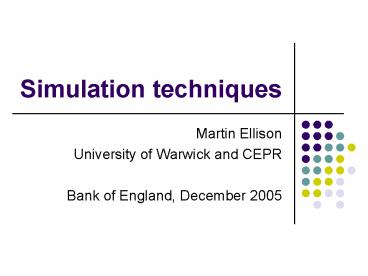Simulation techniques PowerPoint PPT Presentation
Title: Simulation techniques
1
Simulation techniques
- Martin Ellison
- University of Warwick and CEPR
- Bank of England, December 2005
2
Baseline DSGE model
Recursive structure makes model easy to simulate
3
Numerical simulations
- Stylised facts
- Impulse response functions
- Forecast error variance decomposition
4
Stylised facts
- Variances
- Covariances/correlations
- Autocovariances/autocorrelations
- Cross-correlations at leads and lags
5
Recursive simulation
- 1. Start from steady-state value w0 0
2. Draw shocks vt from normal distribution
3. Simulate wt from vt recursively using
6
Recursive simulation
4. Calculate yt from wt using
5. Calculate desired stylised facts, ignoring
first few observations
7
Variances
8
Correlations
9
Autocorrelations
10
Cross-correlations
- Correlation with output gap at time t
11
Impulse response functions
- What is effect of 1 standard deviation shock in
any element of vt on variables wt and yt?
1. Start from steady-state value w0 0
2. Define shock of interest
12
Impulse response functions
3. Simulate wt from vt recursively using
4. Calculate impulse response yt from wt
using
13
Response to vt shock
14
Forecast error variancedecomposition (FEVD)
- Imagine you make a forecast for the output gap
for next h periods - Because of shocks, you will make forecast errors
- What proportion of errors are due to each shock
at different horizons? - FEVD is a simple transform of impulse response
functions
15
FEVD calculation
- Define impulse response function of output gap to
each shocks v1 and v2
response to v1
response to v2
response at horizons 1 to 8
16
FEVD at horizon h 1
- At horizon h 1, two sources of forecast errors
17
FEVD at horizon h 1
- Contribution of v1
18
FEVD at horizon h 2
- At horizon h 2, four sources of forecast errors
19
FEVD at horizon h 2
- Contribution of v1
20
FEVD at horizon h
At horizon h, 2h sources of forecast errors
- Contribution of v1
21
FEVD for output gap
22
FEVD for inflation
23
FEVD for interest rates
24
Next steps
- Models with multiple shocks
- Taylor rules
- Optimal Taylor rules
PowerShow.com is a leading presentation sharing website. It has millions of presentations already uploaded and available with 1,000s more being uploaded by its users every day. Whatever your area of interest, here you’ll be able to find and view presentations you’ll love and possibly download. And, best of all, it is completely free and easy to use.
You might even have a presentation you’d like to share with others. If so, just upload it to PowerShow.com. We’ll convert it to an HTML5 slideshow that includes all the media types you’ve already added: audio, video, music, pictures, animations and transition effects. Then you can share it with your target audience as well as PowerShow.com’s millions of monthly visitors. And, again, it’s all free.
About the Developers
PowerShow.com is brought to you by CrystalGraphics, the award-winning developer and market-leading publisher of rich-media enhancement products for presentations. Our product offerings include millions of PowerPoint templates, diagrams, animated 3D characters and more.

